page 8
Progressive Thinkers as of 5/8/2020
|
| ||||||||||||||||||||||||||||||||||||||||||||||||||||||||||||||||||||||||||||||||||||||||||||||||||||||||||||||||||||||||||||||||||||||||||||||||||||||
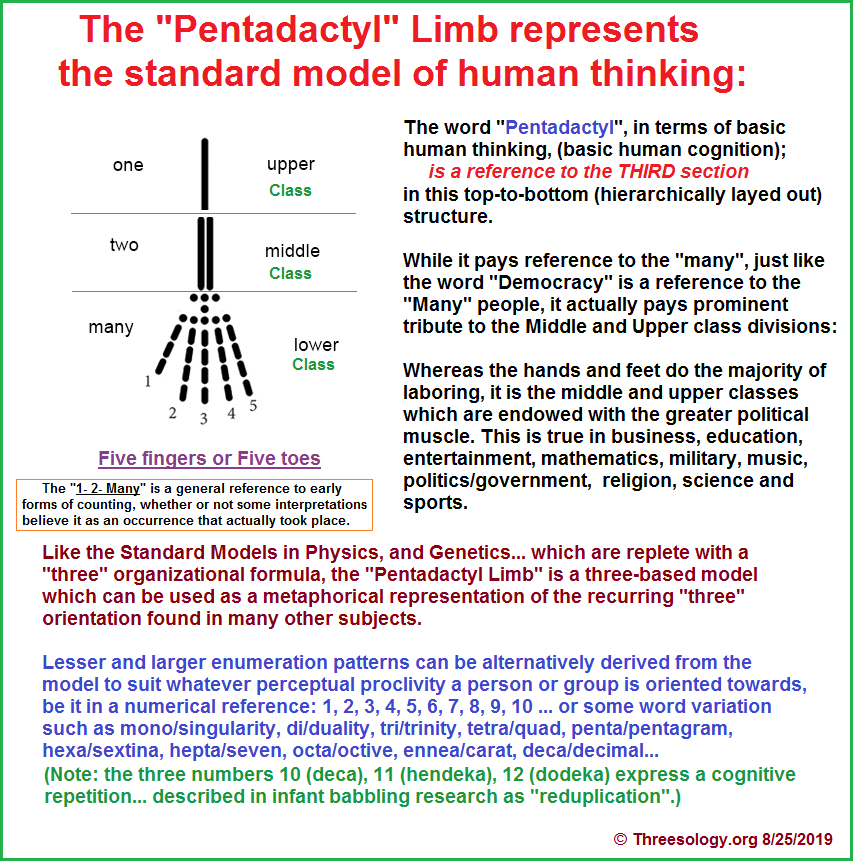
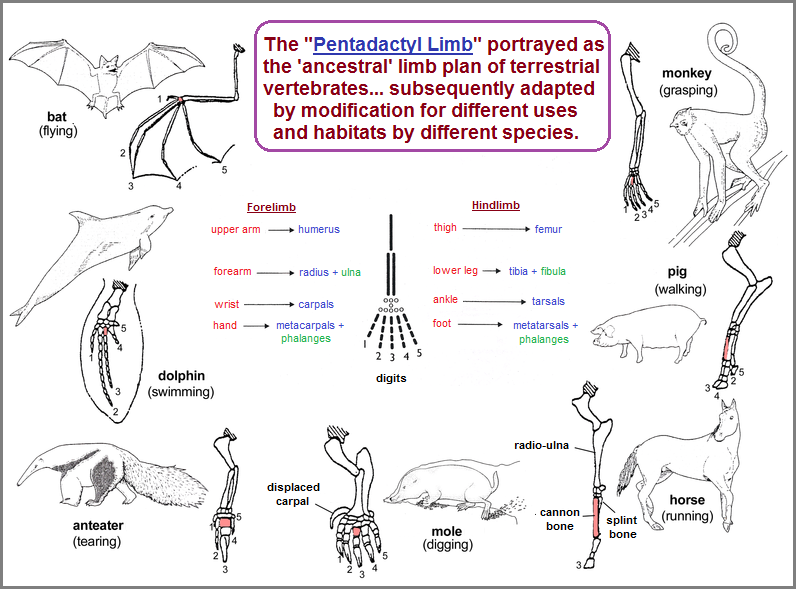
The physics community is too comfortably arrogant with its present vernacular-based ideological suppositions which formulate models that have led us to a dead end that is being viewed otherwise and celebrated with an inebriated form of thinking that is ceremonialized by the Nobel Prize committee which reinforces the celebrations of ideation around which so many physics revolve their creative orientations and regurgitate new variations of old ideas like a florist using the same flowers arranged in a different way or different vases or planters. We need to slap them in the face, step on their toes... if not get them in the shins, in the butt or punch them in the stomach, so as to break them free from a mindset which has created a falsified aura of vulnerability with respect to their orientations of consideration.
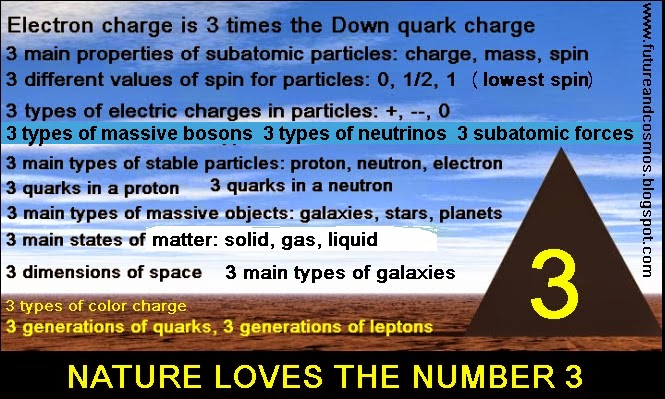
Hence, the "Standard Model" of physics may be a representation not of all particle behavior in all instances, but a recurrence like the recurrence of number patterns, frequented like a seance held by adolescents who create attachments to favorite numbers, favorite patterns/styles, favorites colors, etc... Since we can see a recurrence of the "three" pattern, we should be open to the possibility that this may be one amongst other patterns existing elsewhere. In fact, it may intertwine with other patterns just as we are seeing with the pattern-of-three phenomena in other subject areas, as well as ensembles of certain patterns-of-three and 3-to-1 ratios. For example, a person may be making a list of seven patterns when there are actually ensemble patterns which equal seven, but the ensemble patterns are being overlooked as a primary constituent which is not being recorded because the researcher is not sensitive to the idea of ensemble behavior of numbers... much less particles in physics.
If we look at the Standard Model of particles physics that is frequently partnered with the shell model and then overlay the ideas using a three-patterned Pentadactyl frame, it would seem that we are moving from a circular (planetary-like) dynamic to a static linear formula, until we add movement to the Pentadactyl frame by visualizing a rotating ensemble. In other words, we use the tip of the singular humerus or femur bone as the point of pivotation in an arc of movement like a gyroscope. The more shells in some atomic configurations are synonymous to the increasing number of bones in the Pentadactyl structure, suggesting a weighted end the further we remove ourselves from the central point of pivotation. Like standing on the Earth and being unaware of its speed as being about a thousand miles per hour at the equator, a similar effect is occurring in particle physics. No less, we can extend the analogy to that of a multi-gear bicycle (since the variations are more easily seen than the multi-gearing of an automobile or motorbike transmission); in that the smaller sprockets turn faster than the larger sprockets which have a larger diameter.
The analogy between particle interaction and placement need not be exact when making a philosophical comparison to the Pentadactyl Limb, since we are looking for a type of comparison which permits us to identify a further grasp of appreciation and enhance our "edge" of pursuing an enhanced perspective. While many physicists and interested "lay" persons do this on their own anyway but may not articulate it by speaking or writing an expose', my effort here is little different except for the attempted public illustration by way of a web page.
While different ideas are being generated, we in the public are not privy to private communications amongst physicists whose imaginations dabble with this or that consideration in an attempt to take our knowledge of physics into the next chapter or even next book or series of books by way of a peer-reviewed article. If you have no standing in the current physics community, your ideas, be they brilliant or otherwise, will not become common knowledge if you are unable to provide a stark representation that gets attention. No less, if your ideas are good but you present them in such a way that they can be plagiarized to the extent someone in or near the physics community can claim them as their own, it may well be difficult to defend your assertion of originality if the plagarizer has the backing of other professionals that may or may likewise profit from their support. Science can be a very competitive sport, though there are many who prefer to practice a preferred camaraderie which includes an unimpeachable honesty to give credit where credit is due.
If we can view the Pentadactyl limb as a Standard Cognitive Model, then it is not far-fetched to consider its application as at least a rough translation that can be applied to other subject areas, unless in reverse, it is a model representing a crude translation of some other model that is already existing or is yet to be found. In any case, whether we look upon it as an Earth with an imagined center point or as the Sun as the central point; both perspectives can be utilized as a foothold by which a greater grasp of fundamental particles and forces might be interpreted. However, to do so, one must be willing to provide the connections which others in a given subject area are not able to because of their embraced ideas of standard considerations which can interfere with appreciating inter-connections with words and a language their own vernacular finds as being an unfamiliarity, crudeness, unreliable commonness, or otherwise irrelevant or impertinent to their routinization of thought.
Let us take a review of the overall human skeleton, noting that the presence of "sets" take place, which can be entertained in other subjects by a simple application of different labels, though the word "set/sets" is already used in Mathematics. Nonetheless, the existence of sets, or collections, or assemblages, or cells, etc., is a recurring theme. The reader should also note that I am trying to offer an analogy by which the study of particle physics might benefit:
Appendicular skeleton
- The limb bones develop in three stages from axial condensations in the local mesoderm. The shoulder and pelvic supports are comparable sets, as are the bones of the arms and legs.
Articulations
- Some type of joint exists wherever bones meet. Joints that allow little or no movement consist of connective tissue, cartilage, or bone. Movable joints arise as fluid-filled clefts in mesoderm, which condenses peripherally into a fibrous capsule.
Source: "prenatal development." Encyclopædia Britannica Ultimate Reference Suite, 2013.
The human body, like that of most animals, develops from a single cell produced by the union of a male and a female gamete (or sex cell). This union marks the beginning of the prenatal period, which in humans encompasses three distinct stages:
- The pre-embryonic stage, the first two weeks of development, which is a period of cell division and initial differentiation (cell maturation).
- The embryonic period, or period of organogenesis, which lasts from the third to the eighth week of development.
- The fetal period, which is characterized by the maturation of tissues and organs and rapid growth of the body.
The prenatal period ends with parturition and is followed by a long postnatal period. Only at about age 25 years are the last progressive changes completed.
Prenatal Development
The point at which two or more bones meet is called a joint, or articulation. Joints are responsible for movement, such as the movement of limbs, and stability, such as the stability found in the bones of the skull. There are two ways to classify joints: on the basis of their (1) structure or on the basis of their (2) function. The structural classification divides joints into (four descriptives):— bony, fibrous, cartilaginous, and synovial joints... depending on the material composing the joint and the presence or absence of a cavity in the joint.
Classification of Joints on the Basis of Function divides joints into three categories— synarthroses, amphiarthroses, and diarthroses:
H.O.B note: When we look at the types of joint movement, one can not help but transfer the date into an image of movement amongst atomic nuclei. There is a pivot (pivotation) movement from which further articulation may or may not occur depending on the type of joint, which may well be the case for particle behavior as well, particularly when fractions (fractionations) are used as points of measurement. The idea that bones are articulated from a point of pivotation induces the presence of an image representing the planetary model of atomic nuclei, with a central point of attachment in a shell-like configuration. Do the types of movements occurring with joints also occur with atomic particles under different conditions... and not necessarily with all particles? Is the makeup of particles similar to that of humans in that one terrain burdens one person while the same person comes alive in another territory, weather condition, time of day, etc...? However, the physics of today only recognizes two types of momentum: Angular and Linear. Movement at Synovial Joints The wide range of movement allowed by synovial joints produces different types of movements. The movement of synovial joints can be classified as one of four different types: gliding, angular, rotational, or special movement.
Source: Joints and Skeletal Movement |
If it is true that atomic particles have only two kinds of movement related to momentum, is there any unrecognized movement which may give the appearance of having no momentum? For example... metaphysically speaking, if the so-called One God is omnipresent (present everywhere), then does this mean this God is motionless because there is no need for movement if one exists everywhere at the same time?
Since physicists work with the notion of conservation, would it not be better for a particle to conserve its energy if it would slide between points instead of walk, run, jog or other physical activity?... metaphorically speaking. Is the vacuum of space equivalent to a slippery surface that once an object is in motion, it does not stop until obstructed by another object or friction?
In terms of atomic particles, when we think of angular momentum from the perspective of linear motion, and then add to this the view of atomic nuclei as being both a particle and wave, these "pronoun"-cements routinely overlook there stature as associating dichotomies or dualities and not necessarily opposites. Such views reference the minds of those involved in the perceptions which must be questioned because of the recurring presence of other number-related patterns, such as patterns-of-three, four, five, six, etc... If the viewers in the physics community are inclined towards a two-patterned perspective and not some other pattern such as three, four, five, etc., this may then be not a standard view of particle behavior/existence, but the currency of thought amongst influential researchers. In other words, their cognitive inclinations are imposed on the data being reviewed and how subject matter is studied... as well as the type(s) 0f experimentation undertaken.
We do not customarily think of an atomic particle as a moving object with a molten core or standardized tilt at its polar end as well as the functionality of a wobble and the triaxial shape of the overall character profile, like that of the Earth. If we were to miniaturize the Earth to an atomic or sub-atomic particle size, would this then explain some of the behavior of atomic particles now being researched? If atomic particles live in shells akin to planetary bodies, then perhaps the internal behavior might be seen as a similarity, though external particle behavior appears at times to be like free-lance journalists going hither-and-tither in search of that which will define themselves as being unique entities amongst their peers.
In addition, if the minds of standardized particle physics inquiry should ever be inclined to view atomic particles as moving wheels which occur in sets like those of an automobile, motorcycle or other internally combustible engine-driven vehicle, which are subject to a periodic 3-point alignment known as Caster, Camber, and Toe. It is situation in which a particular direction and tilt force a wheel to conform to a specification to create a compartmentalized effect in conjunction with a set of moving objects (wheels) to perform so that a connected-to body achieves a destination in the best possible way.
With respect to particles, we may not necessarily look for sets-of-two, three or four, much less larger sets (such as seen in larger trucks), where multiple sets (of moving/rotating objects) may occur in conjunction with one another, though the interaction together would be more difficult to distinguish if the body of the truck and axles were invisible, and did not have a close proximity to an overall object that is quite familiar. In other words, if particle behavior sometimes occurs in sets connected to an "invisible" (unseen/unrecognized) body whose length and width do not conform to current patterns of thinking about interactive particles, then the overall situation amongst atomic nuclei is not seen as a possible dot-to-dot scenario of visualization. For example, if we did not know what an automobile or semi-truck looks like and the wheels occurred together at a large distance apart, the tracks of a vehicle which was stopped and the tracks of the same vehicle in continuous motion (forwards, backwards, turning here, turning there, or creating a circular path, etc.), may not be linked as the same object. In fact, the three-point alignment would be overlooked.
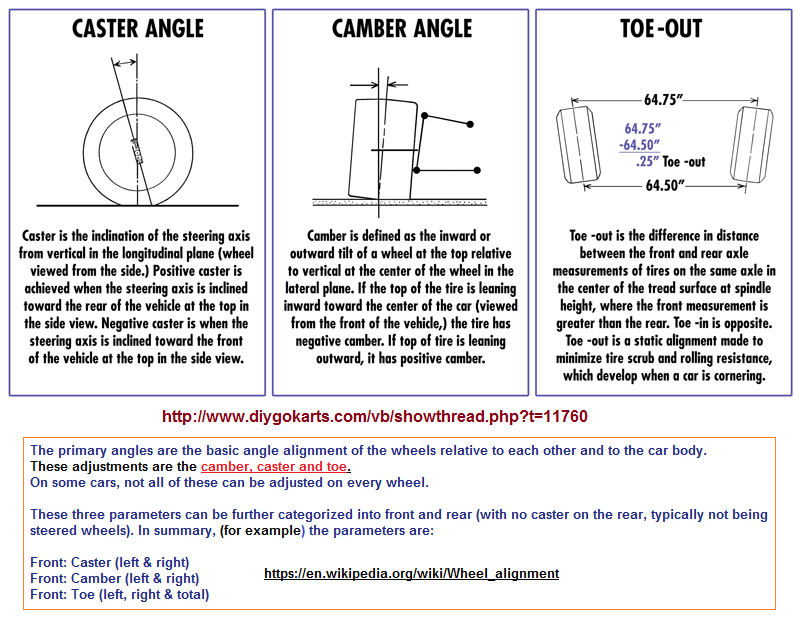
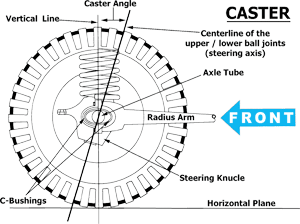 |
Caster is the fore or aft slope of the steering axis. The steering axis is a line drawn through the upper and lower ball joints of the knuckle. Positive caster is when the bottom of the steering axis line is in front of the tire's contact patch. Zero caster is when the steering axis is at 0 degrees. Factory alignment specs for basically all vehicles call for a certain degree of positive (shown) caster. This ensures good stability, helps maintain straight-ahead direction and promotes steering wheel self-centering. |
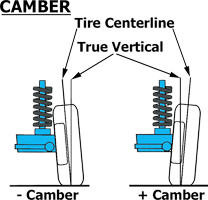 |
Camber is the inward or outward tilt of the front tires as viewed from the front. Inward tilt is negative, outward tilt is positive. Camber is used to distribute load across the entire tread. Improper camber makes the tire wear on one edge, and causes the vehicle to pull to the side that has the most positive camber. |
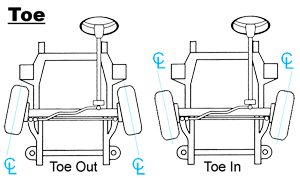 |
Toe is the side-to-side difference in distance between the front and rear of the front tires. If the distance is closer at the front, it's called toe-in. If the difference is closer at the rear, it's called toe-out. |
We must ask why atomic particles and their sub-atomic brethren appear to play out a conservative role from the perspective of humans on Earth, both of which are functionally conservative themselves. In other words, are particles limited in their movements or is this due to human perception engaged in a practice of seeking out repetition that is deduced as an expression of conservation? Clearly repetition suggests a gaming situation, as referenced on these two pages: Links of interest page 1, Links of Interest page 2.
Date of Origination: Monday, 25th May 2020... 4:33 AM
Date of Initial Posting: Thursday 18th June 2020... 10:26 AM